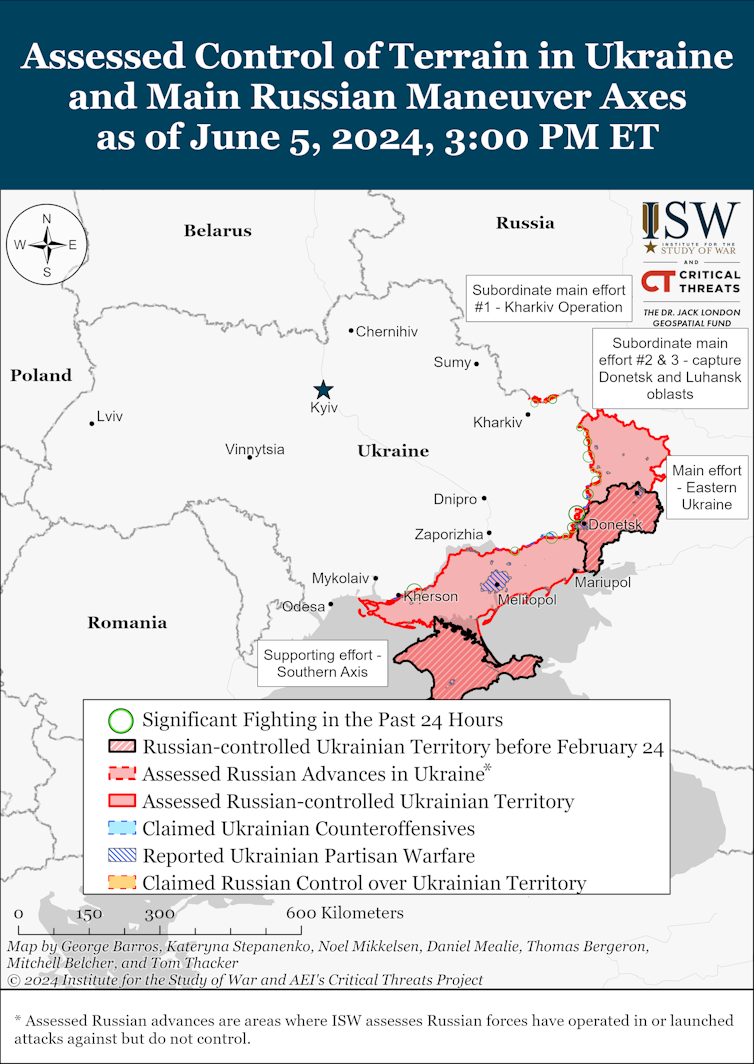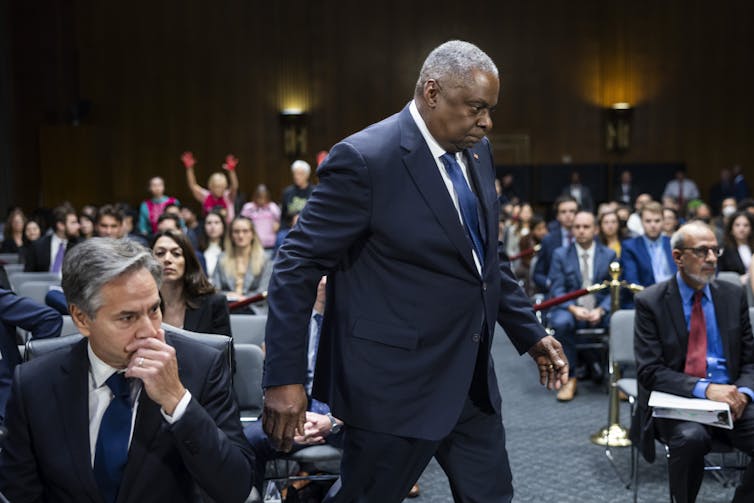When missiles fired from Ukraine destroyed a S-300/400 air defence battery on Russian territory over the weekend of June 1 and 2, it immediately gave rise to speculation that the missiles were from US high mobility artillery rocket systems, or Himars. It was assumed they were part of the large package of military aid which was finally approved by Washington at the end of April.
The reason for this assumption is that Ukrainian missile systems do not have a sufficient range to hit those particular targets, which were situated in a field in Russia’s Belgorod Oblast, which borders Ukraine. The site was an estimated 80kms from the Ukrainian city of Kharkiv, which has itself come under heavy bombardment from inside Russia.
The question of whether Ukrainian military units would be allowed to use western-supplied weapons to attack targets inside Russia has come up many times since Putin launched his invasion in February 2022. For two years, the supply of arms from the US and Kyiv’s other western allies came with a strict prohibition against attacking targets outside Ukraine.
This was because of the very real fear in the west that Russia’s president, Vladimir Putin, would use it as an excuse to escalate hostilities – particularly against the Nato member states with which Russia shares a border.
But the lengthy delay while some Republicans in Congress dragged their feet over approving Joe Biden’s US$60 billion (£50 billion) aid package had handed Russia a big advantage on the battlefield. Ukraine’s summer offensive in 2023 had failed to make any significant breakthroughs and during the winter that followed, Russia was able to leverage its numerical superiority and artillery advantage to push Ukraine back at several areas along the frontline.
Ukraine was trying to hold Russia in check to use various means of its own to attack some key targets on Russian territory. In particular, Ukraine has launched drone attacks on targets in Moscow and some of its oil refineries. Kyiv also had some success in targeting naval installations in Crimea.
But the Russian push towards Kharkiv, Ukraine’s second city, which had been under regular bombardment since the beginning of the war, highlighted another problem. Russia was able to use bases on its side of the border to launch airstrikes and glide bombs against Kharkiv and Ukrainian troops in the region.
The Russian military was also able to use the bases as a “sanctuary” in which units could regroup, rearm and return to the fight. Because they were largely out of range of Ukrainian missiles, they could do so in relative safety.
Read more: Should Ukraine attack Russian territory with western weapons? The debate in Nato is shifting
Volodymyr Zelensky had pleaded with Washington to relax its restrictions. The UK, France and Germany all indicated they were willing to do so. And the Nato secretary general, Jens Stoltenberg, made it clear that in his view Ukraine had the right to hit legitimate targets in Russia using any weapons at its disposal. But still Washington held out.
Washington reconsiders
But on May 14, on a trip to Kyiv, the US secretary of state, Anthony Blinken, appeared to signal a more relaxed position than before. He said he thought it was up to the Ukrainians to decide how to use the long-range systems.

The US defence secretary, Lloyd Austin, appeared to contradict Blinken when he said a week later that “our expectation is that they continue to use the weapons that we’ve provided on targets inside of Ukraine”. But his choice of words led some commentators to speculate that there might be exceptions.
As if to confirm this, Austin mentioned the problem of Russia’s air and glide bomb attacks from bases inside the Russian border. As the New York Times recounted, he told journalists: “The aerial dynamic’s a little bit different … And so – but again, don’t – don’t want to speculate on any – any one or – or any type of engagement here at the podium, so…” When pressed, according to the New York Times, Austin did not respond.

By the end of May, the US position had shifted. On May 30, a US official briefed: “The president recently directed his team to ensure that Ukraine is able to use US weapons for counter-fire purposes in Kharkiv so Ukraine can hit back at Russian forces hitting them or preparing to hit them”.
Michael Carpenter, senior director for Europe at the White House National Security Council, later clarified that this would only apply to certain weapons and not Atacms (army tactical missile systems). To the frustration of Ukrainian military planners, the restrictions on the use of weapons against Russian targets still have strict geographical and technical limits.
The importance of these issues cannot be overestimated. Ukraine is now employing a lethal combination of Atacms and increasingly advanced drones to systematically weaken Russian air defences in Crimea, target air bases used by Russian interceptors, and strike key targets. But a continuing US prohibition means it can’t use their Atacms against targets in Russia.
As anticipated by Washington, Russia has responded to the shift in the western stance with renewed threats and hints of the risks of nuclear weapons use. But these threats have are become so commonplace that they have clearly begun to lose their potency.
In any case, as the war progresses, the urgent need to support Ukraine, the conviction that Ukraine must not “lose” this conflict and the diminishing fear of escalation from Russia has resulted in loosening the restraints on the use of western military hardware and the provision of more capable systems.

